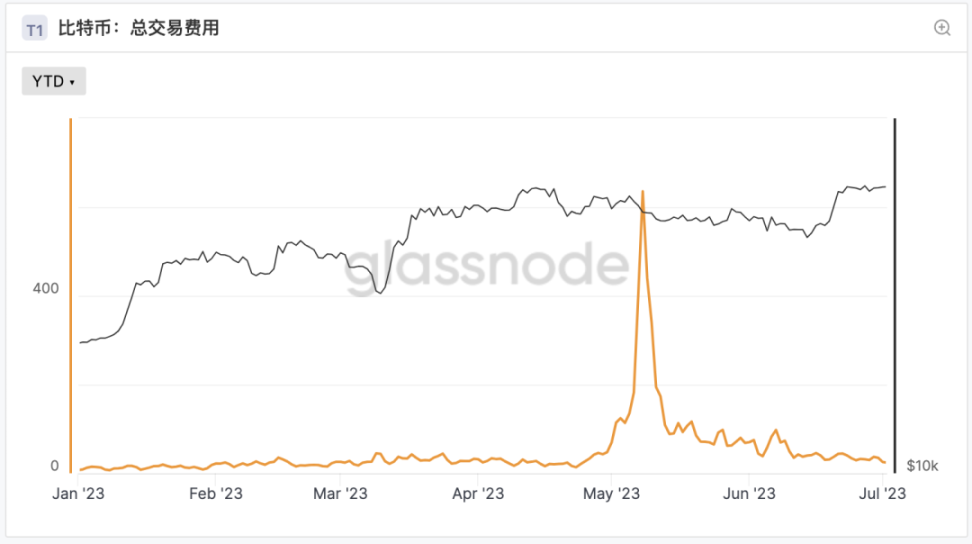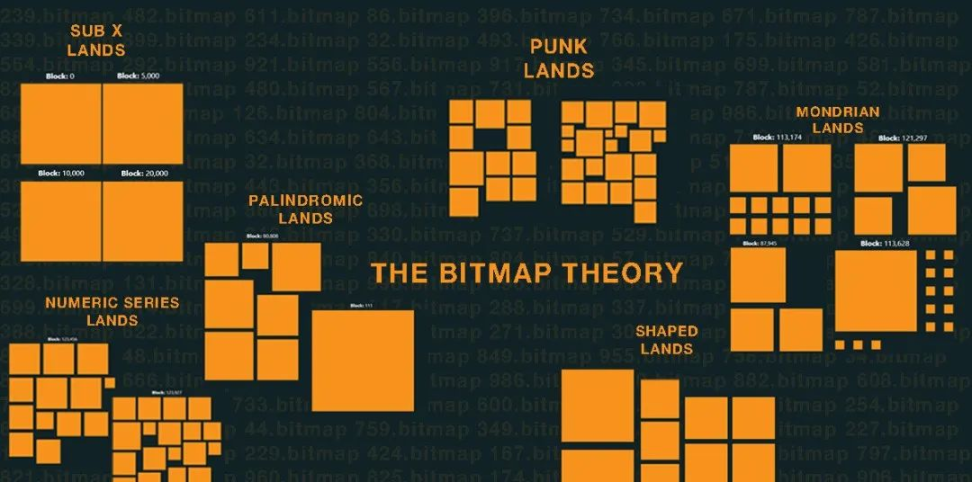What new narratives have emerged from the Bitcoin ecosystem's bear market comeback?
Author: Day, Baihua Blockchain
On July 6, Ethereum founder Vitalik Buterin praised Ordinals for reviving the builder culture of Bitcoin during a Twitter space, stating that Ordinals and the BRC-20 Token standard are a political rejection of stagnation in the Bitcoin ecosystem.
In mid-May this year, the explosive popularity of the BRC-20 protocol led to congestion in the Bitcoin network, with transaction fees skyrocketing. At its peak, transaction volume doubled compared to usual, and block producers earned over $36 million in fees in a week, accounting for 15.9% of total block production revenue.
Additionally, major institutions like Grayscale and Binance have published articles introducing related concepts, the number of Bitcoin Ordinals inscriptions surged from 1 million to 8 million in just 40 days.

The emergence of concepts related to Ordinals and inscriptions in the Bitcoin ecosystem has undoubtedly sparked various discussions among institutions, media, and the community. Some institutions and projects have rushed to position themselves within the Bitcoin ecosystem, with some opinions suggesting that the upcoming bull market will be led by the Bitcoin ecosystem, surpassing the Ethereum ecosystem.
Although many players who FOMO'd into the Bitcoin ecosystem after the brief frenzy in May are currently at a loss, there are still some who continue to cultivate and are optimistic about its future development. Today, let's take a brief look at the new concepts that have emerged in Bitcoin this year.
Ordinals Protocol (Image-based)
On January 21 of this year, software engineer Casey Rodarmor announced the launch of the Ordinals protocol on the Bitcoin mainnet in a blog post, officially starting on January 30. The Ordinals protocol assigns a number to each smallest unit of Bitcoin, the Satoshi, and allows users to write text, images, videos, or audio formats on the Satoshis, completing the transformation of Satoshis from a "smallest unit of Bitcoin" to a "Bitcoin NFT." We refer to Satoshis with various metadata as inscriptions, similar to stamping in our daily lives, "engraving" content onto Satoshis.
Features of the Ordinals Protocol:
- NFT data is fully stored on the Bitcoin chain.
- Bitcoin lacks smart contracts, making it difficult to modify and update NFT content, which is mostly static and cannot be synthesized or destroyed like on Ethereum.
Popular NFTs:
- Ordinal Punks: Launched in late January 2023 on the Bitcoin blockchain, an exclusive collection paying tribute to CryptoPunks;
- Bitcoin Punks: Minted on the Ordinals protocol on February 9, 2023, mimicking the NFT project CryptoPunks on Ethereum, with a total of 10,000;
- Bitcoin Frogs: Released at the end of February 2023, consisting of 10,000 generated frogs, the Bitcoin version of frog NFTs, peaking with daily trading volume surpassing that of other NFT markets;
- TwelveFold: Launched by Yuga Labs on March 4 on Bitcoin, with a total of 300 NFTs, raising $16 million through the auction of 288 NFTs.
At its peak, three of the top ten daily trading volumes in the NFT market were on the Bitcoin chain. However, currently, after checking the trading volume and prices of various NFTs on the Magic Eden platform, the performance of these once-popular NFT projects is now underwhelming.
The launch of the Ordinals protocol sparked intense discussions within the Bitcoin community, with mixed opinions. Opponents argue that the protocol deviates from Satoshi's vision, occupying block space with NFTs, driving up fees, and hindering user experience. Supporters believe that the introduction of the protocol will bring more use cases to Bitcoin and even break Ethereum's monopoly on NFTs.
Currently, at least more people have started using Bitcoin wallets and understanding related concepts, indicating that the benefits outweigh the drawbacks. High fees? It's really not an issue; when Ethereum was hot, people still participated despite congestion. In fact, problems arising can force the industry to continue evolving, and projects can only grow by solving one issue after another. This is evident as the congestion issues from May have led to certain advancements in the Lightning Network and the Bitcoin ecosystem.
BRC-20 (Text-based)
BRC-20 is a standard for issuing fungible tokens based on the Ordinals protocol, launched on March 8, 2023, by Twitter user @domodata, inspired by the Ordinals protocol. It allows for writing unified JSON text data to Satoshis through the Ordinals protocol, specifying a series of functions such as token name, issuance, minting, and transfer.
The name "BRC-20" is derived from the Ethereum ERC-20 token standard, so most people compare the future development prospects of BRC-20 with the current market scale of ERC-20.
Features of BRC-20:
- Data is on the Bitcoin chain and difficult to modify;
- Fair issuance, with "first come, first served" after deployment;
- Due to Bitcoin's low programmability, scalability is limited.
Representative Projects (Mainly Text-based):
- ORDI: On March 9, the first BRC-20 token issued by BRC-20 founder @domodata, with a total of 21 million, is the leading project in the BRC-20 space, reaching a market cap of over $600 million at its peak.
- BRC-20 is essentially a meme; apart from different names, there is no essential difference among BRC-20 projects. Most people value the special meaning or historical significance represented by the name. The overall market cap of BRC-20 reached over $1 billion, with ORDI accounting for a large portion. Currently, the BRC-20 space has cooled down, and if any project emerges, it will undoubtedly be ORDI.
Rare Satoshis
Due to the popularity of Ordinals, Satoshis, as the carriers of inscriptions, have naturally attracted attention, leading to the emergence of concepts related to rare Satoshis.
One Bitcoin consists of 100 million Satoshis. As mentioned earlier, the Ordinals protocol assigns a number to each Satoshi, and each Satoshi has its own number. Regarding the rarity of Satoshis, the official documentation of Ordinals explains that based on Bitcoin's own block production, difficulty adjustments, halving, and other periodic events, a rarity concept is artificially assigned to Satoshis, giving them collectible value.
 Proportions of various types of Satoshis
Proportions of various types of Satoshis
In addition to the aforementioned categories, some Satoshis with historical significance, special characters, and other features are also highly sought after. In simple terms, it’s about finding the uniqueness of Satoshis compared to others. Similar to playing with ENS domain names, three-letter, four-letter, palindromic, and other domains with special meanings are expensive due to their scarcity. Those interested can look for more information on how to engage with this.

Classification of rare Satoshis on the Ord.io platform
Recursive Inscriptions
Due to the popularity of Ordinals and BRC-20, developers have begun to update and iterate on BRC-20, primarily focusing on how to reduce file size to save gas. Notable examples include ORC-20, BRC-721 (analogous to BRC721), GBRC-721, etc. Among them, BRC-721 stores images directly on Bitcoin, increasing storage pressure on Bitcoin, while GBRC-721 allows NFTs to be divided into different components for upload, reducing storage pressure while enhancing the composability of each component. Recursive inscriptions are proposed based on the GBRC-721 technology.
Recursive inscriptions were proposed by Casey Rodarmor, the founder of the Ordinals protocol. On June 12, 2023, Raph, the new chief developer of Ordinals, merged the "recursive inscriptions" numbered 2167 proposed by Casey Rodarmor into the Ordinals protocol, officially launching the recursive feature in version 0.6.2.
To simply understand the concept of recursive inscriptions, if you need to issue 10,000 NFTs, you would originally need to upload 10,000 images. Now, you only need to upload 200 features of the NFT and then create 10,000 inscriptions that "reference" the uploaded features for combination. This saves on-chain resources, and the uploaded features are open-source, allowing anyone to "reference" them.
This allows for mutual referencing and invocation between inscriptions, breaking the previous situation where each inscription was independent and unconnected, opening up infinite possibilities for free combinations through their composable nature.
Features of Recursive Inscriptions:
- Recursiveness, combining multiple unrelated inscriptions into forms such as graphics, hypertext, web pages, videos, and games, enabling recursive calls and interactions between inscriptions, bringing more possibilities and functionalities;
- Lower costs, breaking through the 4MB block size limit of Bitcoin by using recursive rules to call existing inscription components for combination, avoiding the high costs of directly inscribing high-definition images;
- Image components are recorded on the Bitcoin chain;
- Achieves similar functionality to smart contracts through recursive calls.
Related Projects:
- Recursive Playground: The first interactive generative art recursive inscription NFT, with a total of 333, allowing users to interact with it using a mouse to change its appearance. Currently, only one experience NFT has been released;
- Recursive Frogs: A collection of recursive high-definition NFTs, consisting of frog NFTs, with a total of 1,000;
- Bitmap: Metaverse land that connects all players.
 Some land gameplay on Bitmap
Some land gameplay on Bitmap
- Ordz games: The first Bitcoin game, which has already conducted three seasons.
Bitcoin Scaling
In 2021, Bitcoin achieved the Taproot upgrade through a soft fork, expanding Bitcoin's block space from 1MB to 4MB. However, the development of BRC-20 this year has still led to severe congestion in the Bitcoin network, with gas fees exceeding 600 sats/vB at the worst times, while currently, gas fees range between 7-10 sats/vB. One can imagine the congestion in the Bitcoin network at that time.
During this period, a certain exchange announced twice the suspension of BTC withdrawals, subsequently increasing withdrawal fees and stating that it would integrate the Bitcoin Lightning Network, which in turn promoted the construction of the Bitcoin ecosystem. The congestion in Bitcoin is generally believed to be solvable through the Lightning Network.
Related Projects:
- Taro Protocol: Developed by the core team of the Lightning Network, Taro is a new Taproot-driven protocol that allows users to create assets on the Bitcoin blockchain and send them via the Lightning Network for fast, low-cost transactions.
- Stacks: One of the few compliant projects, a leading second-layer project for Bitcoin, utilizing Bitcoin's security and Stacks tokens (STX) to implement smart contracts. As Bitcoin faces congestion, Stacks is researching the use of second-layer technologies (such as the Lightning Network) to expand network throughput and transaction speed, launching Stacks 2.0 to achieve high throughput, low cost, and instant settlement transactions.
- RIF: RIF stands for "Root Infrastructure Framework," an ecosystem built on the Bitcoin network aimed at providing solutions to support the development, deployment, management, and scaling of decentralized applications.
Conclusion
The above outlines the new narratives evolving on the Bitcoin chain this year. It is evident that various technologies are continuously iterating and upgrading, with new developments emerging periodically. The progression of various events is interconnected; even if one does not participate, understanding the development history can assist in making informed judgments and choices if the Bitcoin ecosystem truly takes off in the future. While new tracks nurture new opportunities, the risks are also significant, so DYOR.











